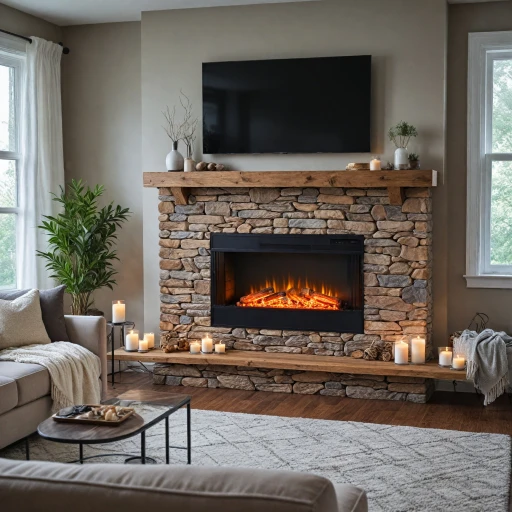Understanding the Benefits of Electric Fireplaces
Why Electric Fireplaces Are Worth Considering
Electric fireplaces have been getting their fair share of the limelight recently, and for good reason. The advantages they bring to the table are numerous, catering to modern needs and desires.- Energy Efficiency: Electric fireplaces convert electrical energy directly into heat with little waste, making them a highly energy-efficient option when compared to traditional wood or gas-burning options. This efficiency translates into lower bills, which is always a win for your wallet.
- Easy Installation: One of the standout features of electric fireplaces is the ease of installation. Compared to gas fireplaces that require ventilation systems and more complex setups, an electric insert can be installed without much hassle.
- Minimal Maintenance: With no ash or soot to clean up, electric fireplaces reduce the time and effort you spend cleaning, leaving you with more time to enjoy the warmth and ambiance.
- Advanced Safety Features: No need to worry about exposed flames or gas leaks, making them a safer alternative especially in homes with children or pets. The risk of carbon monoxide exposure is zero, giving you peace of mind.
- Versatile Aesthetic: Whether your style is modern or traditional, there's an electric fireplace out there that fits your aesthetic. They come in a variety of designs, including sleek wall-mounted units and fireplace inserts that mimic traditional flames with log sets.
- Customization: Many models feature adjustable heat settings and flame effects, allowing you to tailor the experience to your liking. This flexibility means you can enjoy the cozy atmosphere even during warmer months without the added heat.
Assessing the Feasibility of Conversion
Evaluating the Possibility of Switching to an Electric Model
When contemplating how to upgrade your cozy hearth from gas flames to the modern ease of electric, it’s essential to consider several factors. Thanks to advancements in technology, electric fireplaces have evolved into more efficient and aesthetically pleasing options for any home. Before heading into a transformation project, here's what you should weigh:- Home Configuration: Check your existing fireplace setup. Is it built into a wall, or does it sit as a standalone insert? Knowing if you have a gas log fireplace or a wood-burning option will affect how much work needs to be done during conversion.
- Chimney Suitability: Electric units do not require a chimney, unlike their wood-burning cousins. This means if your existing gas model uses a chimney for proper exhaust, you’ll find an electric fireplace more practical and energy efficient in its operation.
- Electricity Access: Confirm there is access to electricity in your current fireplace location. Installation for some electric fireplaces might necessitate rewiring, though many inserts can conveniently plug into a standard household outlet.
Cost Implications of Converting to Electric
Figuring Out the Price of Switching
Thinking about giving your living room a cozy facelift by swapping your gas fireplace for an electric one? It’s a decision not just taken lightly, as every penny counts! First, it’s helpful to know that the financial impact of such a conversion hinges mainly on a few key factors. Let’s break them down:- Installation Costs: While gas fireplaces demand regular maintenance due to venting and potential gas leaks, electric fireplaces come with a simpler installation process, often eliminating the need for pricey professional help. Yet, if undoing a built-in gas unit is part of your project, expect some demolition work that might ramp up those initial expenses.
- Energy Efficiency: Switching to electric could lead to a noticeable drop in your utility bills compared to the consumption rate of natural gas or propane fireplaces. Electric fireplaces convert all of their energy into heat without generating byproducts, making them an energy efficient option.
- Fireplace Insert Choices: Whether you're eyeing a wall-mounted unit or a classic electric insert, your choice will affect the overall cost. The price range is broad—you can find budget options as well as high-end models featuring advanced technology.
- Long-Term Savings: Besides saving on energy costs, electric fireplaces demand less upkeep compared to gas or wood-burning options. No need to worry about carbon monoxide safety measures or chimney maintenance.
Step-by-Step Conversion Process
Preparing for the Transition
Switching from a gas fireplace to an electric one might sound like a big task, but with the right steps, it can be a straightforward process. First, ensure your current setup is ready for the change. Start by turning off the gas supply to your existing fireplace. This is crucial for safety and will prevent any accidental leaks. Once the gas is securely off, remove any gas logs or inserts from the fireplace.
Removing the Old Setup
With the gas components out of the way, it's time to clear the space for your new electric insert. This might involve taking out any old trim or decorative elements that won't fit with the new design. Make sure the fireplace area is clean and free from debris, as this will make the installation smoother.
Installing the Electric Insert
Now comes the exciting part—installing your new electric fireplace insert. Most electric inserts are designed to fit into existing spaces, making them a convenient option. Follow the manufacturer's instructions closely, as each model may have specific installation requirements. Typically, this involves sliding the insert into place and securing it with screws or brackets.
Electrical Connection
Electric fireplaces require a power source, so ensure there's an electrical outlet nearby. If your fireplace doesn't have one, you might need to hire an electrician to install an outlet. Once everything is set up, plug in your electric insert. Test it to make sure it heats properly and that all features are working.
Finishing Touches
After installation, you can add any finishing touches like a new trim or mantel to enhance the look of your fireplace. This is also a good time to consider any additional safety features, such as a screen or glass door, to keep children and pets safe.
Choosing the Right Electric Fireplace Model
Picking the Suitable Electric Fireplace for You
Choosing the right electric fireplace model is all about aligning it with your home and lifestyle needs. There's no one-size-fits-all, so let's explore the choices to make an informed decision.- Fireplace Inserts and Built-Ins: These are perfect if you wish to convert a wood burning or gas fireplace into electric. They fit snugly into the existing structure, offering the traditional charm with electric efficiency. Electric fireplace inserts also come with options like log sets and surround trim to complete the look.
- Wall-Mounted Fireplaces: If keeping things sleek and modern is your vibe, wall-mounted electric fireplaces might be just the ticket. They can turn any room into a statement space while saving floor area, unlike traditional gas log setups.
- Free-Standing Models: These are plug-and-play wonders. They don't require any complicated installation and can be moved around to heat any space you prefer. Great for renters or those who enjoy rearranging their rooms frequently.
- Size and Heat Output: Consider the size of the area you're aiming to heat. Electric fireplaces, though energy efficient, vary in the amount of heat they produce. Larger rooms will benefit more from a powerful model, while small spaces can get by with a less robust option.
- Cost and Efficiency: While contemplating the transition from gas to electric, factor in the cost of the unit and its ongoing operation. Electric is usually more cost effective in the long run, especially with usage patterns that play to its strengths in zone heating.
Maintenance and Safety Tips for Electric Fireplaces
Keeping Your Electric Fireplace Running Smoothly
Maintaining an electric fireplace can be a breath of fresh air compared to its gas or wood-burning counterparts. However, it still requires some attention to keep it in tip-top shape. Routine maintenance not only extends the lifespan of your electric fireplace but also ensures that it operates safely.Regular Cleaning and Inspection
- Dusting: Keep the exterior and interior parts free from dust. Use a soft, damp cloth to wipe the surface regularly.
- Inspecting For Damage: Regularly open the electric insert to check for any signs of wear such as frayed cords or broken lights.
- Cleaning the Filter: Some models come with a filter, so ensure it’s cleaned to maintain efficient heating.
Ensuring Safe Operation
Electric fireplaces are renowned for having safety features that gas fireplaces may lack, such as no carbon monoxide emissions. Nonetheless, certain safety practices are paramount:- Proper Ventilation: Even though an electric insert doesn't require a flue, make sure it's installed where there's good air circulation.
- Avoid Overloading Circuits: Don’t plug your electric fireplace into an extension cord or power strip; a direct connection to a wall outlet is best.
Heat Efficiency Considerations
- Optimized Heating: Electric fireplaces are energy efficient; however, ensure your room size and the fireplace's output are a match for efficient heating.
- Timely Replacement of Lights: If your model uses LED lights to mimic a burning fireplace, ensure they are replaced when they dim or stop working.









